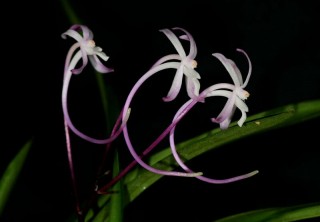Loading
Search
▼ Japan’s Most Familiar Orchid Is Found To Have Near-Identical Cousin
- Category:Other
All the Spiranthes on the Japanese mainland were thought to be a single species, but in fact there are two
In Japan, a country with a rich and ancient history of horticulture, it is nowadays extremely rare for a new plant species to be identified. But the latest one has been growing under their noses, and it is exceptionally beautiful.
Spiranthes hachijoensis, whose rosy pink petals bear a striking resemblance to glasswork, can be found in common environments such as lawns and parks, and even in private gardens and on balconies, and yet until now it had not been named.
That is because until now it was believed that all the Spiranthes on the Japanese mainland were a single species, when in fact there are two.
Spiranthes australis, commonly known to gardeners in the west as lady’s tresses, is Japan’s most familiar orchid. It has been cherished – and documented – there for centuries, even appearing in the Manyoshu, Japan’s oldest extant anthology of poetry, dating back to AD759.
It was while looking at Spiranthes australis during fieldwork that Prof Kenji Suetsugu, of Kobe University, noticed that some apparently common or garden Spiranthes had hairless stems while most were notably furrier.
Suetsugu and colleagues from Tohoku University and the Taiwan Forestry Research Institute embarked on a decade-long study of the flowers, collecting specimens from locations in Japan, Taiwan and Laos.
Integrating results from DNA analysis, morphology, field observations and reproductive biology, Suetsugu and his associates discovered that the new hachijoensis taxon was a cryptic species exhibiting a high level of molecular divergence from their australis cousins, despite their apparent similarities.
Spiranthes hachijoensis often grows alongside Spiranthes australis, but blooms about a month earlier.
That the common Spiranthes is actually divided into two species is likely to pique the curiosity of the general public, researchers say.
Suetsugu added: “This discovery of new species concealed in common locales underscores the necessity of persistent exploration, even in seemingly unremarkable settings.
It also highlights the ongoing need for taxonomic and genetic research to accurately assess species diversity.”
In Japan, a country with a rich and ancient history of horticulture, it is nowadays extremely rare for a new plant species to be identified. But the latest one has been growing under their noses, and it is exceptionally beautiful.
Spiranthes hachijoensis, whose rosy pink petals bear a striking resemblance to glasswork, can be found in common environments such as lawns and parks, and even in private gardens and on balconies, and yet until now it had not been named.
That is because until now it was believed that all the Spiranthes on the Japanese mainland were a single species, when in fact there are two.
Spiranthes australis, commonly known to gardeners in the west as lady’s tresses, is Japan’s most familiar orchid. It has been cherished – and documented – there for centuries, even appearing in the Manyoshu, Japan’s oldest extant anthology of poetry, dating back to AD759.
It was while looking at Spiranthes australis during fieldwork that Prof Kenji Suetsugu, of Kobe University, noticed that some apparently common or garden Spiranthes had hairless stems while most were notably furrier.
Suetsugu and colleagues from Tohoku University and the Taiwan Forestry Research Institute embarked on a decade-long study of the flowers, collecting specimens from locations in Japan, Taiwan and Laos.
Integrating results from DNA analysis, morphology, field observations and reproductive biology, Suetsugu and his associates discovered that the new hachijoensis taxon was a cryptic species exhibiting a high level of molecular divergence from their australis cousins, despite their apparent similarities.
Spiranthes hachijoensis often grows alongside Spiranthes australis, but blooms about a month earlier.
That the common Spiranthes is actually divided into two species is likely to pique the curiosity of the general public, researchers say.
Suetsugu added: “This discovery of new species concealed in common locales underscores the necessity of persistent exploration, even in seemingly unremarkable settings.
It also highlights the ongoing need for taxonomic and genetic research to accurately assess species diversity.”
- March 18, 2023
- Comment (0)
- Trackback(0)


